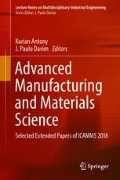Abstract
This study is an attempt to establish a novel technique for the synthesis of Chitosan (CS)—Polystyrene (PS) blends to achieve specific combination of physical properties. The CS–PS blends were synthesized from homogenous solutions at different ratios of the polymers. An attempt is made to improve their functionality by doping them with mixed metal oxide nanocomposites of ZnO–TiO2 synthesized by an electrochemical thermal technique. The obtained nanocomposite doped polymer blends are appropriately characterized by Fourier Transform Infrared Spectroscopy (FT-IR) to confirm functional groups. It indicates the formation of blends due to intermolecular hydrogen bonding between the 2 components. SEM images substantiate the presence of nanoparticles in the blends. Thermal stability of these polymers is analyzed by Thermogravimetric Analysis (TGA) and Differential Scanning Calorimetry (DSC). X-ray diffraction (XRD) analysis confirms the amorphous nature of the synthesized blends. These studies reveal that the obtained blends could have potential physiochemical applications as adsorbents for dyes in the treatment of effluent water from textile industries.
Access this chapter
Tax calculation will be finalised at checkout
Purchases are for personal use only
References
Pfaendner R (2010) Photo-oxidation of polypropylene/montmorillonite nanocomposites. 1. Influence of nanoclay and compatibilizing agent. Polym Degrad Stab 95:369–373
Stejskal J, Sapurina I, Trchov´a M, Konyushenko EN (2008) oxidation of aniline: polyaniline granules, nanotubes, and oligoaniline microspheres. Macromolecules 41:3530
Wei Y (2001) Nonclassical or reactivation chain polymerization: a general scheme of polymerization J Chem Educ 78:551
Ciric-Marjanovic G, Trchova M, Stejskal J (2008) Theoretical study of the oxidative polymerization of aniline with peroxydisulfate: tetramer formation. Int J Quantum Chem 108:318
Tzou K, Gregory RV (1992) Kinetic study of the chemical polymerization of aniline in aqueous solutions. Synth Met 47:267
Wei Y, Sun Y, Tang X (1989) Effects of p-aminodiphenylamine on electrochemical polymerization of aniline. J Phys Chem 93:4878
Ortiz RP, Facchetti A, Marks TJ (2010) High-k organic, inorganic, and hybrid dielectrics for low-voltage organic field-effect transistors. Chem Rev 110:205
Chiang CK, Popielarz R (2002) Polymer composites with high dielectric constant. Ferroelectrics 1:275
Cao Y, Smith P, Heeger AJ (1993) Counter-ion induced processibility of conducting polyaniline. Synth Met 55–57:3514–3519
Winie T, Jamal A, Hanif NSM, Shahril NSM (2014) Hexanoyl chitosan-polystyrene blend based composite polymer electrolyte with surface treated TiO2 fillers. Key Eng Mater 594–595:656–660
Yu CL et al (2012) Sci China Chem 55:1802–1810
Sang CK et al (2003) Physical 103:130
Waghmare VG, Kariya KP, Paliwal LJ (2011) J Mater Sci Eng B1:485
Munnawar et al (2017) Synergistic effect of chitosan-zinc oxide hybrid nanoparticles on antibiofouling and water disinfection of mixed matrix polyethersulfone nanocomposite membranes. Carbohydr Polym. http://dx.doi.org/10.1016/j.carbpol.2017.08.036
Dhanavel et al (2014) Photocatalytic activity of Chitosan/ZnO nanocomposites for degrading methylene blue. Int J chemtech 1880–1882
Hanif NSM, Shahril NSM, Azmar A, Winie T (2015) Studies on the effect of acid treated TiO2 on the electrical and tensile properties of hexanoyl chitosan-polystyrene-LiCF3SO3 composite polymer electrolytes. In: American Institute of Physics Conference Proceedings 1674, 020028-1-020028-7
Acknowledgements
Authors thank the Principal, St Aloysius College (Autonomous), Mangalore for providing the Laboratory and experimental facilities for the research work carried out.
Author information
Authors and Affiliations
Corresponding author
Editor information
Editors and Affiliations
Rights and permissions
Copyright information
© 2018 Springer International Publishing AG, part of Springer Nature
About this paper
Cite this paper
Mascarenhas, N.P., Goveas, J.J., Gonsalves, R.A., Shetty, T.C.S., Crasta, V. (2018). Facile Synthesis and Characterisation of Nanocomposite Doped Chitosan—Polystyrene Polymer Blends. In: Antony, K., Davim, J. (eds) Advanced Manufacturing and Materials Science. Lecture Notes on Multidisciplinary Industrial Engineering. Springer, Cham. https://doi.org/10.1007/978-3-319-76276-0_26
Download citation
DOI: https://doi.org/10.1007/978-3-319-76276-0_26
Published:
Publisher Name: Springer, Cham
Print ISBN: 978-3-319-76275-3
Online ISBN: 978-3-319-76276-0
eBook Packages: Chemistry and Materials ScienceChemistry and Material Science (R0)

